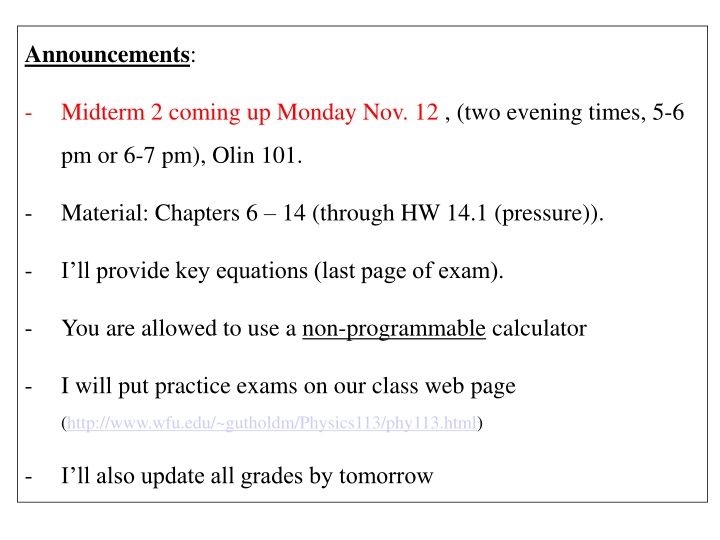
Static Equilibrium and Elasticity Concepts
Prepare for the upcoming midterm by reviewing the material on static equilibrium and elasticity. Learn about conditions for static equilibrium, treatment of gravitational forces, and problem-solving approaches. Practice exams and key equations provided. Stay updated on grades and exam details.
Download Presentation

Please find below an Image/Link to download the presentation.
The content on the website is provided AS IS for your information and personal use only. It may not be sold, licensed, or shared on other websites without obtaining consent from the author. If you encounter any issues during the download, it is possible that the publisher has removed the file from their server.
You are allowed to download the files provided on this website for personal or commercial use, subject to the condition that they are used lawfully. All files are the property of their respective owners.
The content on the website is provided AS IS for your information and personal use only. It may not be sold, licensed, or shared on other websites without obtaining consent from the author.
E N D
Presentation Transcript
Announcements: - Midterm 2 coming up Monday Nov. 12 , (two evening times, 5-6 pm or 6-7 pm), Olin 101. - Material: Chapters 6 14 (through HW 14.1 (pressure)). - I ll provide key equations (last page of exam). - You are allowed to use a non-programmable calculator - I will put practice exams on our class web page (http://www.wfu.edu/~gutholdm/Physics113/phy113.html) - I ll also update all grades by tomorrow
Chapter 12: Static Equilibrium and Elasticity Reading assignment: Chapter 12.1 to 12.4 Homework 12 (due Thursday, Nov. ): QQ1, QQ3, OQ2, OQ9, AE2, 3, 10, 11, 33, 28, 39, 49 Objects in static equilibriumdon t move, Fnet = 0, net = 0 Important for posture of human body, biomechanics. Important civil and mechanical engineers and architects. We ll also learn about elastic (reversible) deformations. Plastic deformations are irreversible (like play dough).
Conditions for static equilibrium Objects in static equilibrium don t move or rotate.
Conditions for static equilibrium (For extended objects) We restrict ourselves to forces in the x-y plane. Thus: 1. The net force acting on the particle must be zero. F = 0 = 0 F x 2. The net torque about any axis acting on the particle must be zero. = 0 F y = 0 = 0 3. The angular and linear speeds must be zero. z
How do we treat the gravitational force? Center of gravity m r i i = i r CM M Consider an extended object. - The gravitational force mg always acts on the center of gravity! - The center of gravity is equal to the center of mass (see Chapter 9) (unless gravity is not uniform)
Problem-solving approach: Objects in static equilibrium. (we will only consider objects that are homogeneous, symmetric, and in a uniform gravitational field.) 1. Draw a free body diagram. - Show and label all the external forces acting on the object. - Indicate where the forces are applied. 2. Establish a convenient coordinate system for forces. Then apply condition 1: Net force must equal zero. 3. Establish a convenient coordinate system for torque (pick convenient pivot). Then apply condition 2: Net torque must equal zero.
Black board example 12.1 Balanced Rock (Garden of the Gods, Colorado Springs) For this system to be in static equilibrium, the center of gravity must be over the support point.
Black board example 12.2 A uniform 40.0 N board supports a father (800 N) and daughter (350 N) as shown. The support is under the center of gravity of the board and the father is 1.00 m from the center. (a) Determine the magnitude of the upward force n exerted on the board by the support. (b) Determine where the child should sit to balance the system.
Upper arm Black board example 12.3 Biceps Under arm 10 kg You are holding a 10 kg mass as shown schematically in the picture. Your underarm (of negligible mass) is 0.5 m long, and your biceps muscle attaches to the underarm at 0.05 m from the elbow joint. With what force is your biceps muscle pulling on the underarm bone? A) 10 N B) 98 N C) 490 N D) 980 N 4900 N
Black board example 12.4 A person with weight 700 N stands d = 4.00 m away from the wall on a l = 10.00 m beam, as shown in this figure. The weight of the beam is 3000 N. (a) Find the tension in the wire. (b) Find the horizontal component of the hinge force. (c) Find the vertical component of the hinge force (homework).
Elastic properties of solids We will consider three types of deformations and define an elastic modulus for each. 1. Change in length. YOUNG S MODULUS measures the resistance of a solid to a change in its length. 2. Shearing. SHEAR MODULUS measures the resistance to shearing. 3. Change in volume. BULK MODULUS measures the resistance to changes in volume.
Elastic properties of solids Definitions of stress and strain. Stress: Force per unit cross sectional area. Strain: Measure of the degree of deformation.
Elastic properties of solids Young s modulus: tensile stress / F A = = Y tensile strain / L iL
Elastic properties of solids Shear modulus: shear stress / F A = = S shear strain / x h
Elastic properties of solids Bulk modulus: volume stress / F A / P / = = = B volume strain V V V V i i P pressure
Black board example 12.5 A 200 kg load is hung on a wire with a length of 4.00 m, a cross-sectional area of 2.00 10-5 m and a Youngs modulus of 8.00 1010 N/m2. What is its increase in length?













